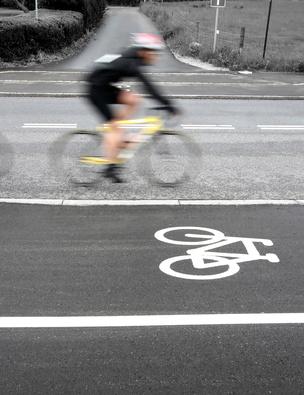Cycling & Kneecap Pain

Cycling is an excellent source of low-impact exercise, but it can cause kneecap pain. The kneecap, or the patella, is a triangular-shaped bone that works with the quadricep tendon above the kneecap and the patellar tendon below the kneecap to power your legs as you pedal. Causes of biking-related kneecap pain can include improper bike fit, overtraining, muscle tightness, muscle weakness and improper body mechanics while riding.
Overtraining
Knee pain is the most common symptom of over-use among cyclists. According to The Physician and Sports Medicine, "Over-use injuries occur when a tissue accumulates damage caused by repetitive submaximal loading. Repetitive activity fatigues a specific structure, such as a tendon or bone." Inadequate rest between rides and dramatic increase in intensity and volume place stress on the patella that it is not prepared to shoulder. To prevent overtraining and overuse injuries, begin at an appropriate level for you, and progress gradually.
Bike Fit
Have a professional bike mechanic or experienced rider fit your bike to your body size and teach you the fundamentals of bike fitting. You should always feel comfortable and safe on your bike. Positioning the seat too low, placing your seat too far forward and using crank arms that are too long place undue stress on the patella and anterior knee tendon. Proper fitting places your body in a correct biomechanical position for efficiency, comfort and injury prevention.
Poor Technique
According to The Physician and Sports Medicine, "The smallest amount of malalignment, whether anatomic or equipment related, can lead to dysfunction, impaired performance and pain." Poor riding techniques like overpronating your foot on the downward pedal phase or riding with your lower leg pointed inward or outward cause the entire lower leg to compensate for these incorrect biomechanical positions, leading to pain and injury. Evaluate your technique, and make the appropriate corrections in small increments to allow your body ample adjustment time.
Stretching
Stretching increases flexibility, lessens muscle tension and improves joint range of motion. According to Rice University, "Muscle tightness in the calf, hamstring, iliotibial band and vastus lateralis are predisposing factors for anterior knee pain." Incorporate dynamic range-of-motion exercises and static stretching exercises during the warm-up phase, while cooling down, during short breaks while riding and when conditioning away from the bike. Proper stretching lessens the chance of injuries and speeds recovery.
Strengthening
Muscle imbalances in the quadriceps can lead to injury and pain. Strengthening the medial aspect of the quads and stretching the outer aspect helps balance the pull on the patella and reduce injury. Single leg squats, Pilates reformer squats, stair step-ups, thigh adduction with the knees flexed to 90 degrees, and isometric contractions while sitting on the floor with a rolled-up towel under your knee and your hip rotated outward 45 degrees will strengthen the inner aspect of the quadriceps.
Note – This information has been taken from different internet sources.
- Choosing a selection results in a full page refresh.

2 comments
ugukuwuvdomay
http://slkjfdf.net/ – Ehehebeso Afaubaino duv.evlt.orthomen.com.vuw.xm http://slkjfdf.net/
cumohawubgip
http://slkjfdf.net/ – Oawele Ejawijo xjx.nqka.orthomen.com.xaz.pu http://slkjfdf.net/